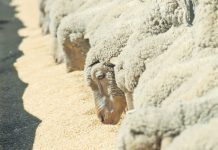
Photo: FW Archive
Fruit orchards across South Africa are expanding rapidly, and it is estimated that the number of beehives available for pollination will have to double over the next decade to meet demand.
Calculations have shown that 65 000 hives are required for the deciduous fruit industry as it stands, with an additional 30 000 needed during the next decade as new orchards come into production. The seed and berry industries collectively require 50 000 hives over the next 10 years.
The macadamia industry needs 160 000 beehives to optimally pollinate the current 40 000ha of macadamias, yet the industry is set to double in size over the next decade.
“As we don’t even have 160 000 hives in the entire country, the need to protect what we have has become crucial to ensure sustainable fruit crop production,” says Dr Hannelie Human of the University of Pretoria’s department of entomology and zoology. “Bees are as important as water to growing most of our food crops, so farmers should be as invested in bee health as they are in orchard health.”
Reasons for the decline
Pesticides have received much attention for their role in the decline in the number of bee colonies, but research points to insufficient forage opportunities as one of the main reasons.
Human notes that pollination depends on colony strength, and any reduction in the number of bees will reduce crop yield.
She adds that in addition to urbanisation, mining activities, air pollution, insecticides and declining natural food sources, farming is providing poorer-quality food for bees, as intensification of agriculture and monocultures limits nutrition for the insects.
“Bees require a diverse diet, and leaving them in an orchard with only one food source for a few weeks, then moving them to another for a few weeks, is not good. It’s like humans being given only chocolate for a month to eat, then bread for another month and meat the next.
“Insufficient forage leads to insufficient honey and pollen reserves to carry bees through winter or a natural period of forage shortage.”
Mike Allsopp, head of honeybee research at the Agricultural Research Council’s (ARC) Plant Protection Research Institute, says that bees forage on flowers only for a reward of pollen and nectar.
“Honeybees can detect minor differences in the sugar concentration present in nectar and in the protein content in pollen. For the most part, they’ll forage on the most rewarding resource available.”
Despite prolific flowering of macadamia trees, the nectar and pollen value is relatively low. The nectar in apple, pear and plum blossoms is relatively poor in both the content of sugar and the quantity. This leads bees to forage instead on weeds such as the Cape weed and wild radish, creating pollination problems for the farmers. But removing these weeds reduces the food source for the bees, leading to weaker colonies.
For this reason, the practice of introducing naive bees (colonies introduced during blossom) has become standard in commercial pollination, says Allsopp.
“Introducing honeybee colonies when target crops are already 20% or more in bloom will result in foragers working on the inferior-quality target crop for a number of days at least, while other foragers locate better-quality forage crops, which the foragers will then switch to. [But] recent results indicate that bees might not switch as readily as thought, and if confirmed, these practices might need to be reviewed.”
He stresses that to keep bees healthy, it is essential to understand which forage resources will best build and sustain their colonies.
“A problem we’ve encountered is that six species of Eucalyptus trees, all excellent bee forage, have been targeted as part of the Working for Water (WfW) programme because they’re invasive alien species that are seen to pose a threat to the natural water sources in certain environmental contexts.
“Some may argue that the assumption that they’re a threat is incorrect, but nevertheless, the programme is widely supported.”
He says that while the primary objective of WfW to increase water yield is “laudable”, it has resulted in the six Eucalyptus species being targeted in all environmental contexts, even when they pose no water threat.
“One could make the case that in many landscape contexts, the associated benefits of an alien plant such as Eucalyptus might outweigh the cost of eradication, and therefore warrant its continued existence in demarcated areas.
“Although research has been done in this regard, it still poses a great challenge, and no real solutions that are in favour of honeybees have been accepted. Greater efforts are needed to change the prevailing narrative and preserve Eucalyptus as bee forage wherever possible.”
Inge Lotter, chairperson of the Mpumalanga Beekeepers’ Association, advises farmers to plant forage areas and cover crops in their orchards to supply a diverse diet that will enable the bees to strengthen their colonies, and hence the work they can do in orchards.
“It’s recommended that trees such as litchi or citrus are also planted on the farm to supplement the bees’ nectar requirement,” she says. “African blue basil, lavender, bottlebrush, aloes, and flowering blackjacks will all sustain honeybee colonies.
“Planting of cover crops such as clover, vetch and lucerne can be considered, as long as it’s in areas away from pesticide applications. A lot of bee forage can be planted on rocky outcrops and road verges. Ideally, one should have plants in all their natural forms, such as pasture, shrubs and trees, to ensure good, varied bee nutrition.”
She notes that healthy swarms need at least 20% protein and 16 different amino acids in their diets, so the more varied the diet, the more offspring the insects can produce and the stronger the swarm will be.
When planting additional forage for bees, farmers should place the hives in such a way
that the bees are forced to fly over the orchards before reaching the more attractive forage areas. This, says Lotter, will ensure that they enter the orchards to pollinate.
The role of pesticides
Human says that in international studies, researchers monitoring wax and honey at various sites have found approximately 160 chemical residues.
“All the culprits we spray on our crops are there. Global studies show that Africa has neonicotinoids present in 73% of its honey, compared with 83% in the US.”

Highlighting the increase in the use of neonicotinoid insecticides, she says that even sub-lethal and field-realistic doses influence honeybees.
“It disorientates them, reduces their ability to forage, causes impaired navigation so they can’t find their hives, and decreases flight ability. Bees taking in neonicotinoids can’t regulate their body temperature, and they die. They fly more slowly and in a smaller area, and bring home less and less food. So there’s less pollination and less food taken into the hive to keep it healthy. Bees also remember the taste of the chemicals and won’t go back to an orchard again if neonicotinoids are being used.”
According to ARC senior researcher Dr Schalk Schoeman, farmers face the dilemma of having to protect both their crops and honeybee populations.
“Monitoring of pests in orchards is very low, and monoculture has resulted in a huge increase in pest load. We can’t avoid a monoculture because that’s the reality of commercial agriculture, but we can improve the situation.
Start by increasing sunlight in the orchards. This creates a stable ecosystem, as grass and weeds can grow between the trees and provide higher biodiversity. Also, the higher the tree density, the higher the pest load. If the density is less, it’s easier to spray if the need arises.”
Farmers should be mindful of a possible ban on endocrine disruptors, glyphosate and organophosphates.
“Farmers need a strategy to combat pests, not just a spray programme. Pruning is crucial to reduce pest load, cover crops are important to get life back into the orchards, and South Africa needs to invest in a pheromone-adaptive facility.”
How farmers can help bees
Even when having to use insecticides, farmers can do much to keep bees safe from chemicals and create optimal conditions for their survival. Inge Lotter, chairperson of the Mpumalanga Beekeepers’ Association, says that when both flowers and fruit are present, extra care should be taken to protect pollinators during pest management applications.
She gives the following tips for applying pesticides:
- Don’t apply pesticides unless absolutely necessary while there are still blossoms in the orchard. This is difficult where several cultivars are present, as flowering periods differ.
- Always follow the instructions on the label.
- Mixing pesticides with sugar will attract bees.
- Do not spray in conditions where spray can drift onto hives or lands supporting bees.
- Early morning in the Lowveld is already hot enough for the bees to come out and forage, so night spraying is advisable. Remember: a wet bee is a dead bee.
- Avoid tank-mixing insecticides and fungicides.
- Fungicides also affect bees, as they limit the fermentation of pollen, making it useless to the bees. This can even lead to starvation of broods dependent on pollen protein.
- Warn beekeepers and neighbouring farmers at least 48 hours before applying pesticides so that they can move or cover their bees.
- Consider drift onto natural bush where other beneficial insects reside.
- Placing hives in dappled shade protects against extreme heat, and placing them
on stands protects against honey badgers and ants.
Email Dr Hannelie Human at [email protected], Dr Schalk Schoeman at [email protected], Mike Allsopp at [email protected], and Inge Lotter at [email protected]













